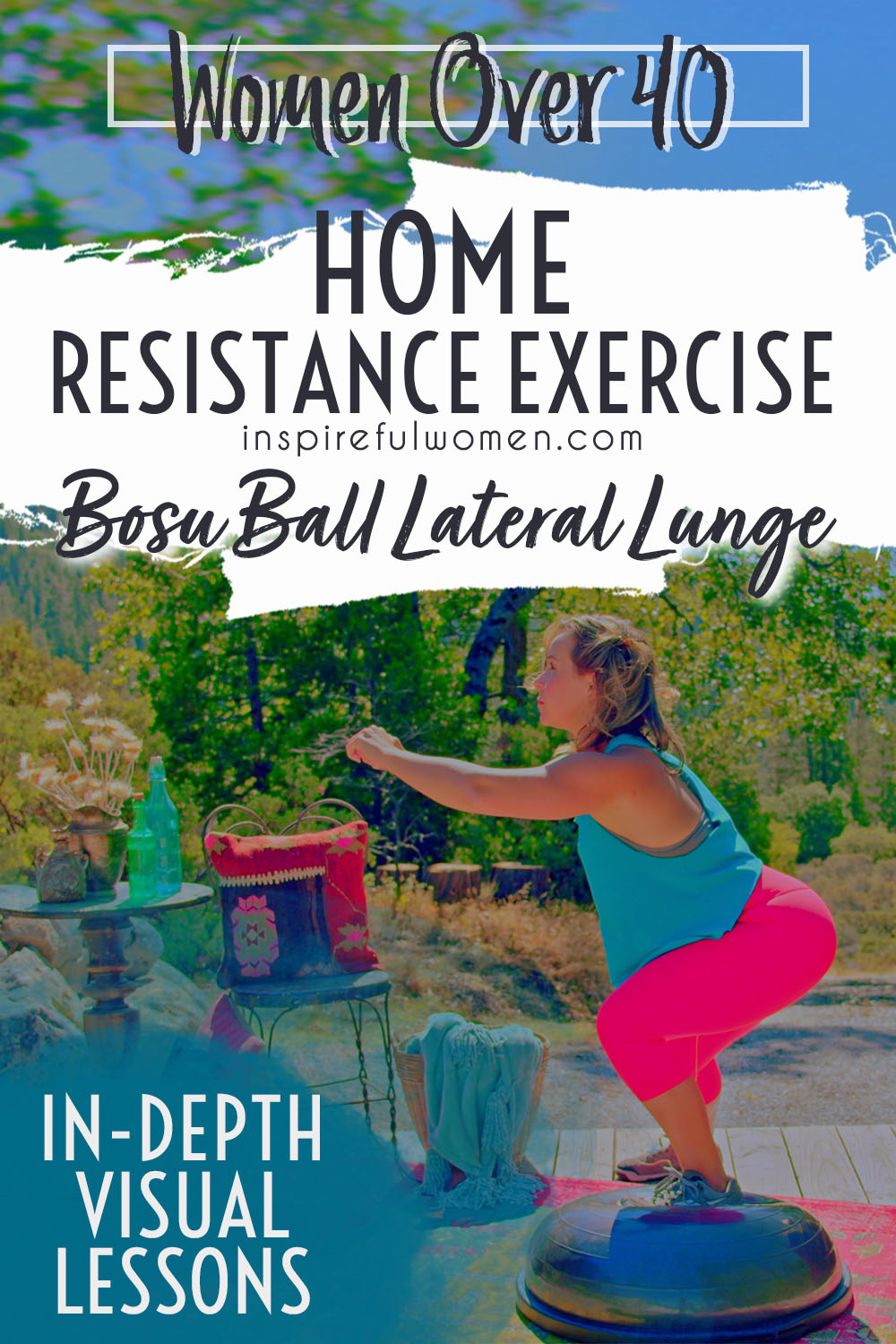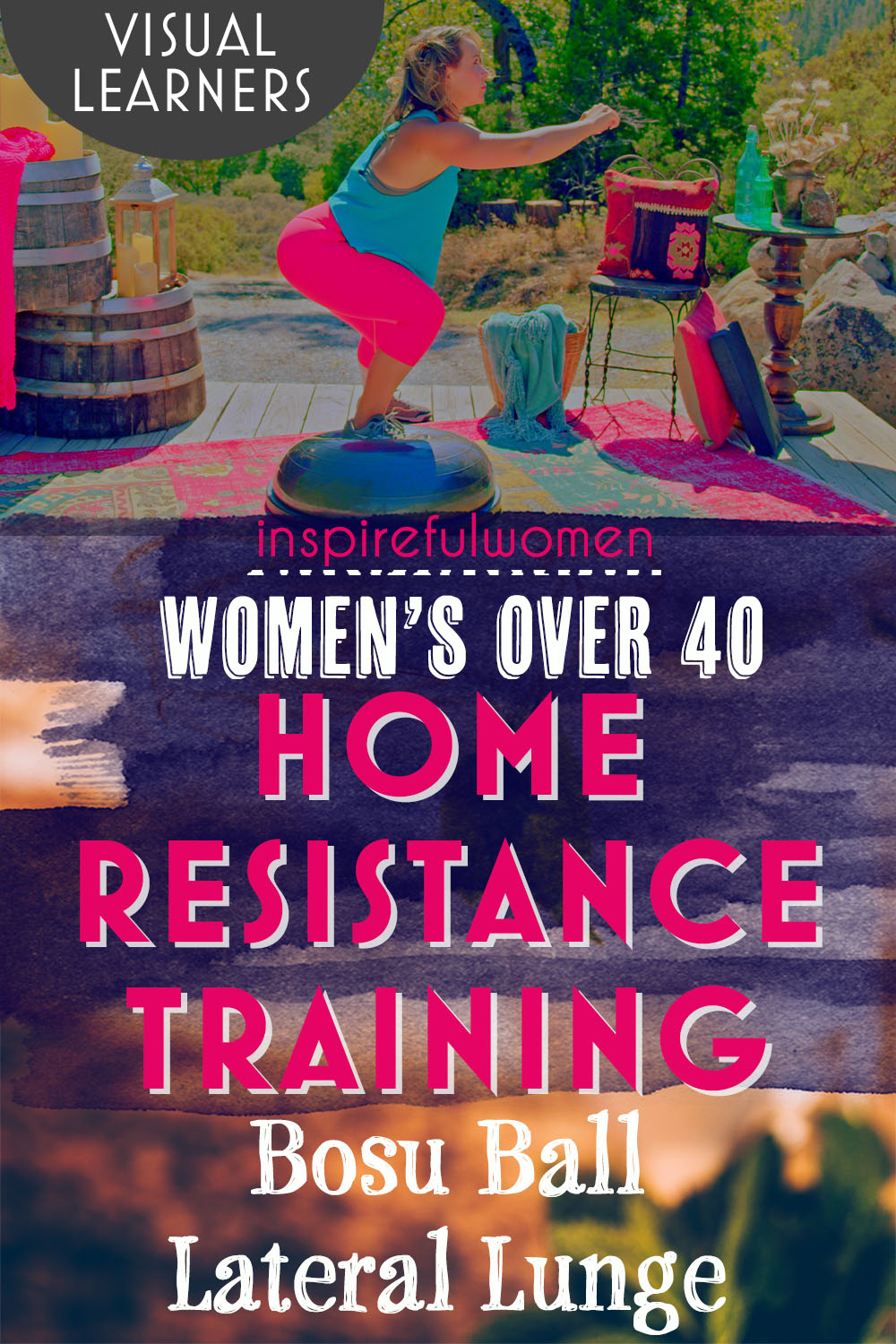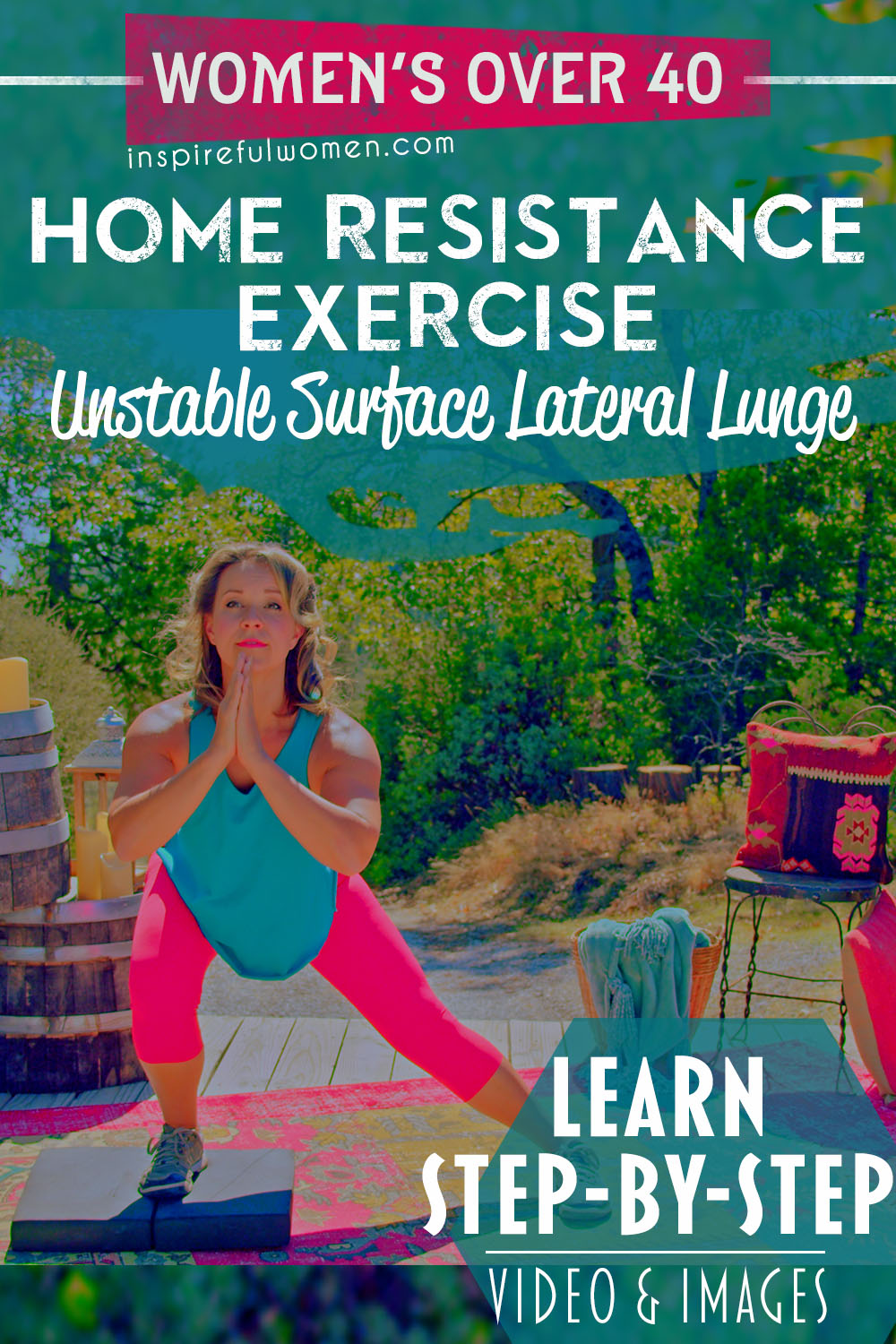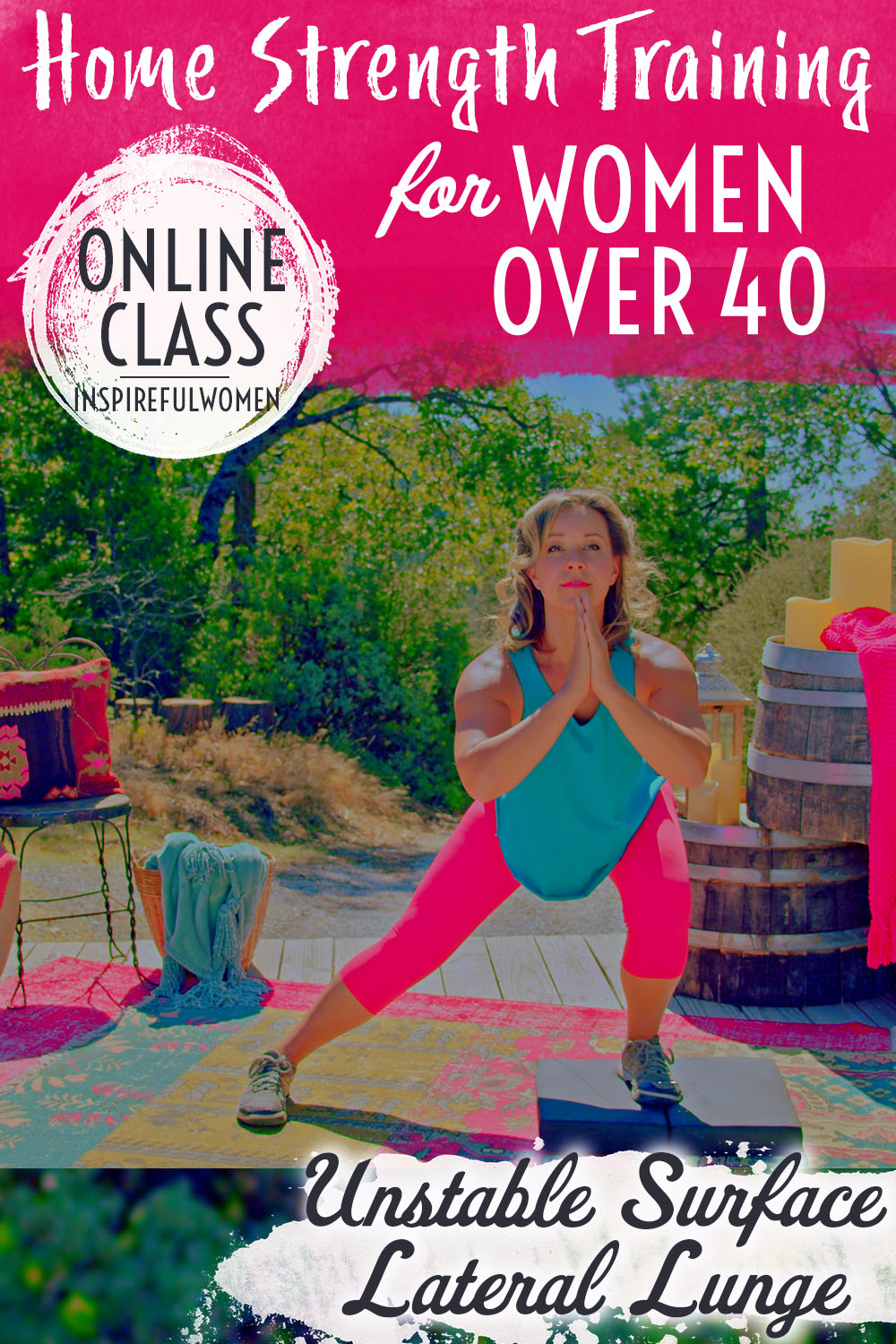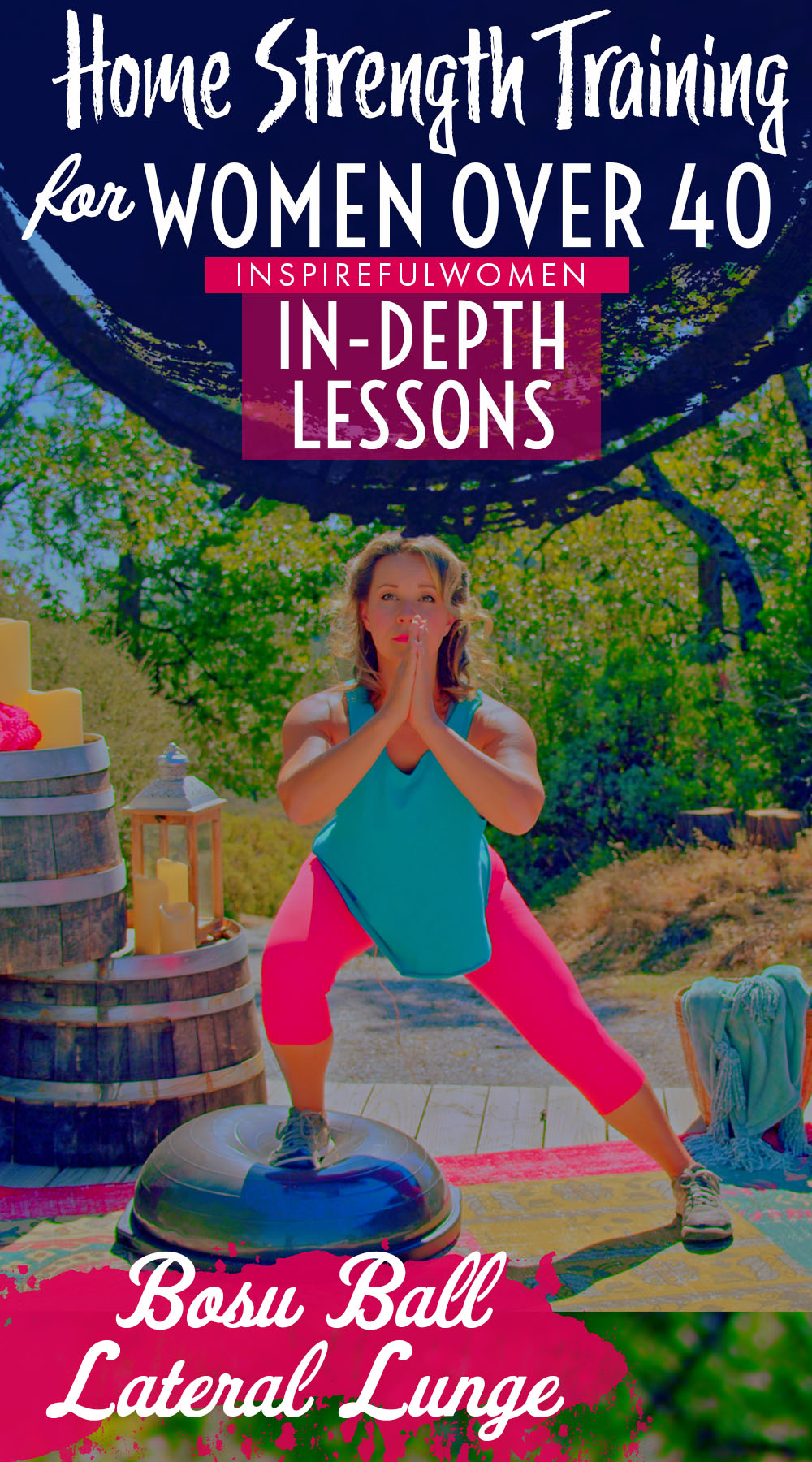Bosu Ball Lateral Lunge
How to Do the Side Lunge on an Unstable Surface - Lateral Split Squat | In-Depth Guide [VISUAL LEARNERS] Intermediate
Proper Form & Common Mistakes | Home Resistance Training
WHAT DO YOU WANT TO SEE?
QUICK DEMO
QUICK DEMO
MUSCLES THIS WORKS
MUSCLES
MAIN MUSCLES WORKED IN the Bosu Lateral Lunge
QUADRICEPS, GLUTEALS, HAMSTRINGS, & ADDUCTORS
OTHER MUSCLES WORKED:
- Gastrocnemius
- Soleus
STARTING POINTERS
Starting Pointers
WHAT WE'RE DOING TODAY
The Bosu Ball lateral lunge is a dynamic, multifaceted exercise that challenges your balance, strengthens your legs, and engages your core.
This version of the lateral lunge is used for training the muscles of the foot, ankle and knee, and balance. When the small muscles of the foot and the muscles that stabilize the ankles and knees are weak, it can lead to poor alignment of the joints during standing, walking and running. This can result in foot, ankle, knee, hip and even low back pain, and other issues like plantar fasciitis, bunions, and frequent ankle sprains.
Strengthening the muscles that cross the knee and hip joints will help improve the alignment of the knee, ankle, and hip and also help to protect the joints from impact that can damage the soft tissues (meniscus and ligaments) and the bones over time.
The movement is done by standing next to an unstable surface, like a stability disc or foam cushion. While trying to stay in good alignment, side step onto the surface with the working leg to complete a lunge. Concentrate on keeping the ankle upright and the arch of the foot lifted (not rolling in).
HOW TO DO THE EXERCISE
LOOKS
HOW Bosu Lateral Lunges SHAPE OUR BODY
Shapes and tones the muscles of the hips, thighs (front, back, inner and outer) and calves.
PROPER FORM
PROPER FORM: Bosu Lateral Lunge
EQUIPMENT, SETS & REPS
EQUIPMENT
Unstable surface: BOSU, stability disc, Airex - unstable foam pad, foam kneeling pad, couch cushion, pillow, or rolled up yoga mat.
SUGGESTED STARTING WEIGHT FOR WOMEN:
Bodyweight
SETS & REPS:
1-2 sets of 8 reps on each side.
PACE:
Slow descent for the eccentric muscle activation, quick (but controlled) return to standing.
BODY POSITION
BODY POSITION FOR THE Bosu Lateral Lunge
Place the unstable surface to your side, about 1.5 to 2 feet away - however, you step when you do a standard lateral lunge.
FEET: Toes pointed forward. Feet normal stance width, approximately 6 -8 inches apart.
LEGS: Knees pointed forwards, straight but not locked.
BODY STANCE: Body weight is distributed equally between your left and right legs. Neutral spine (includes cervical spine), sternum lifted, shoulder blades in and down the back. Shoulders and hips squared to the front.
ARMS: Hands on the top of the pelvis, or at the hip creases.
HOW TO DO
HOW TO DO Bosu Lateral Lunges
CUE: To get the most out of the exercise, pay close attention to the position of your working foot, ankle and knee.
Step out to the side onto the unstable surface with your working leg - approximately 1.5 - 2 feet but this depends on your leg length, joint mobility, and muscle strength and flexibility. The toes of both feet and both knees still pointing forward.
Nearly all of your weight should be on your working leg - your nonworking leg will help stabilize.
Press your hips back, hinging forward slightly at your hips as you lunge down. If your hands were hanging down by your sides - one arm would be on each side of your lunging leg - this is a good way to check your position.
Lunge down until your thigh is parallel to the floor, or less. Only go as far as you are able to while maintaining good form without discomfort (muscles working and a mild stretch is ok). Good form means a neutral spine, knees in alignment, and heels of both feet in contact with the floor.
Hold the bottom position briefly.
Return to the starting position by pressing the heel of your working leg down to straighten your leg and push your body back up as you transfer your weight over towards your non-working leg. Set your foot flat on the floor ready for the next rep.
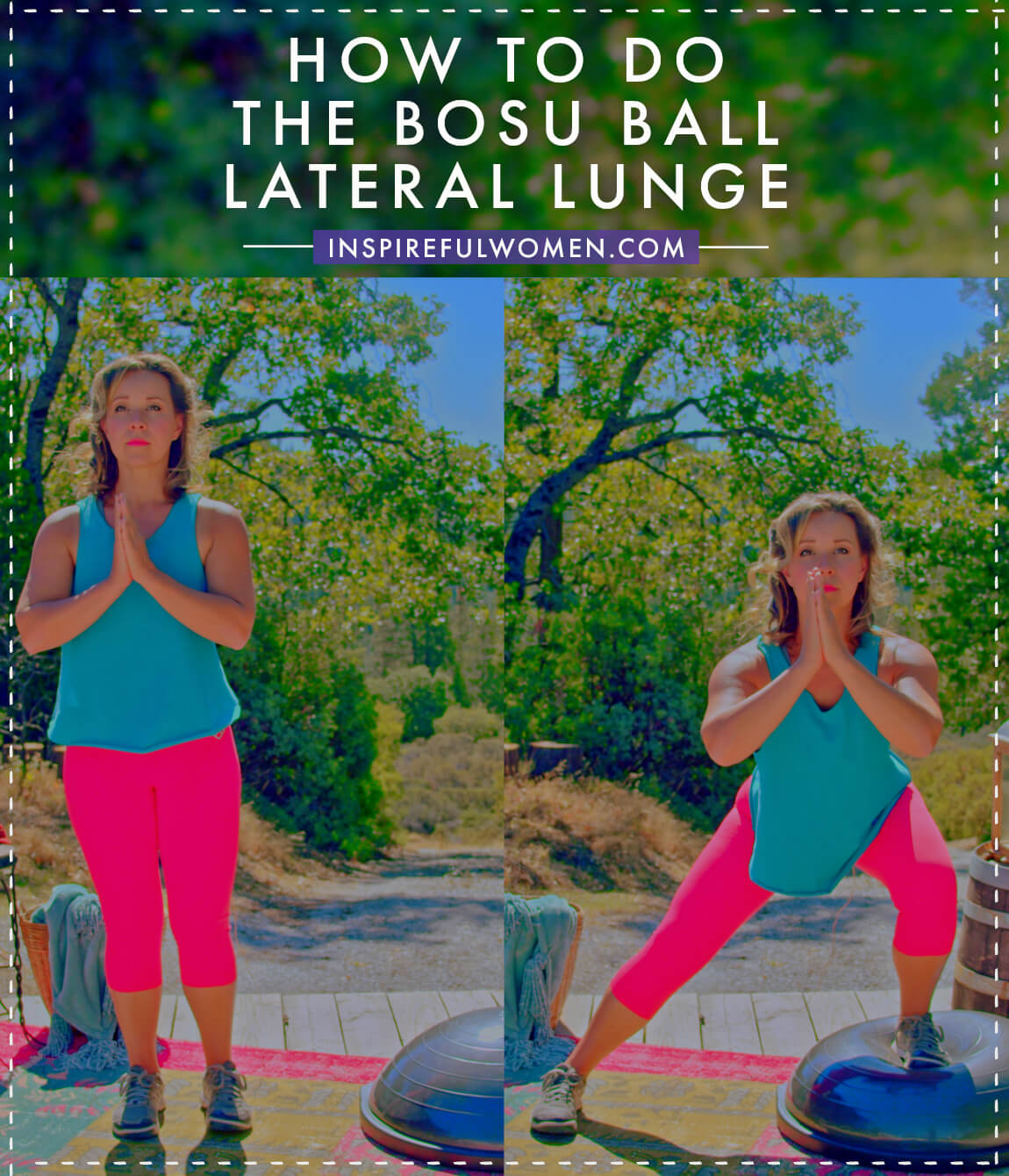
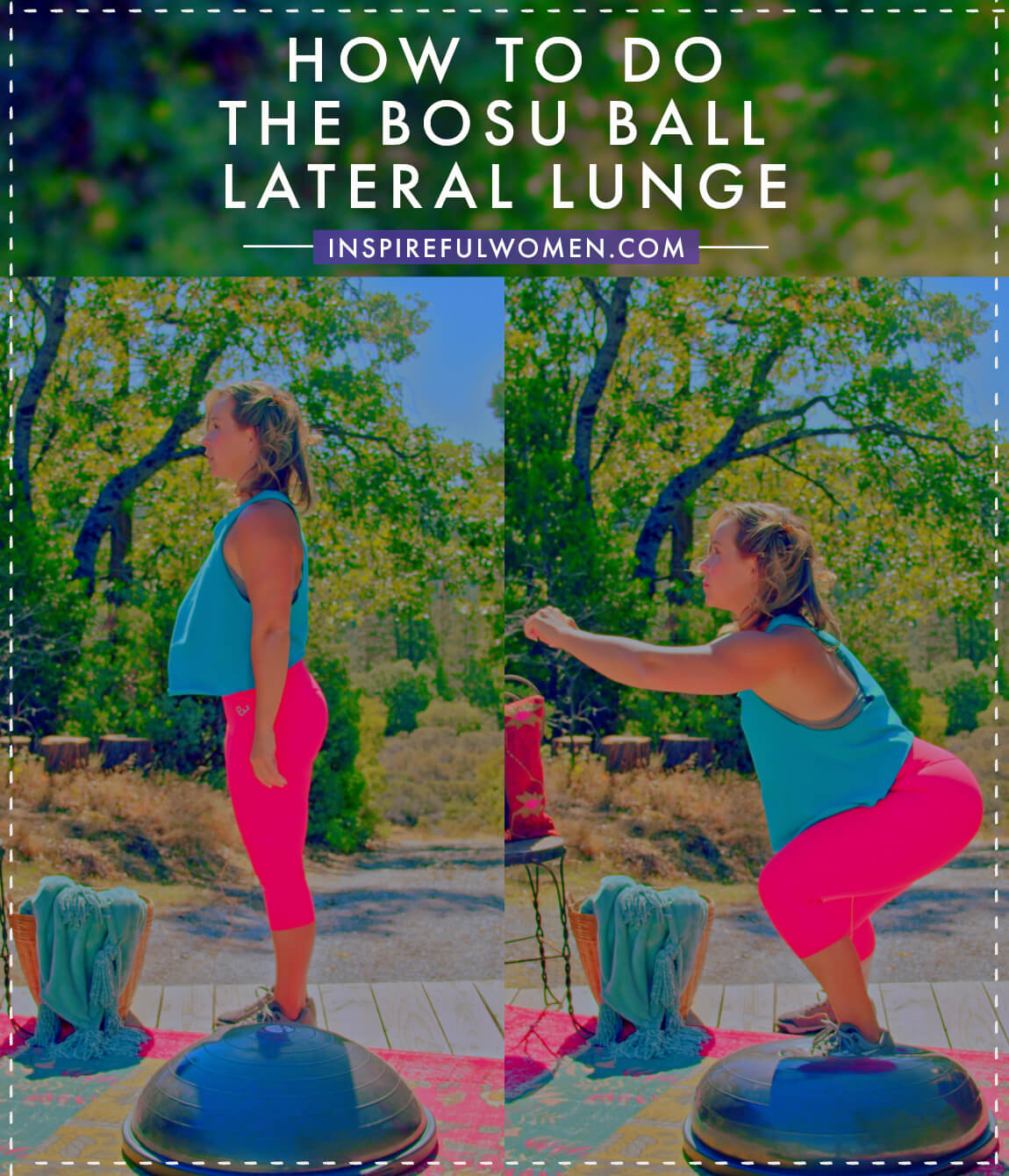
COMMON MISTAKES
COMMON MISTAKES
WHAT TO AVOID WITH THE Bosu Lateral Lunge
KEY TIP:
Guess what? Good news! Many avoids are the same for most movements. Once you learn the basics, there's really only a few extra avoids for each individual movement.
1. Avoid Toe Turning Out
AVOID: Avoid letting the toes on either foot turn out.
WHY NOT?
- This is a common compensation for lack of ankle mobility.
- This is a common compensation for hip abductor weakness.
- This will help improve ankle mobility and strengthen the muscles of the lower legs.
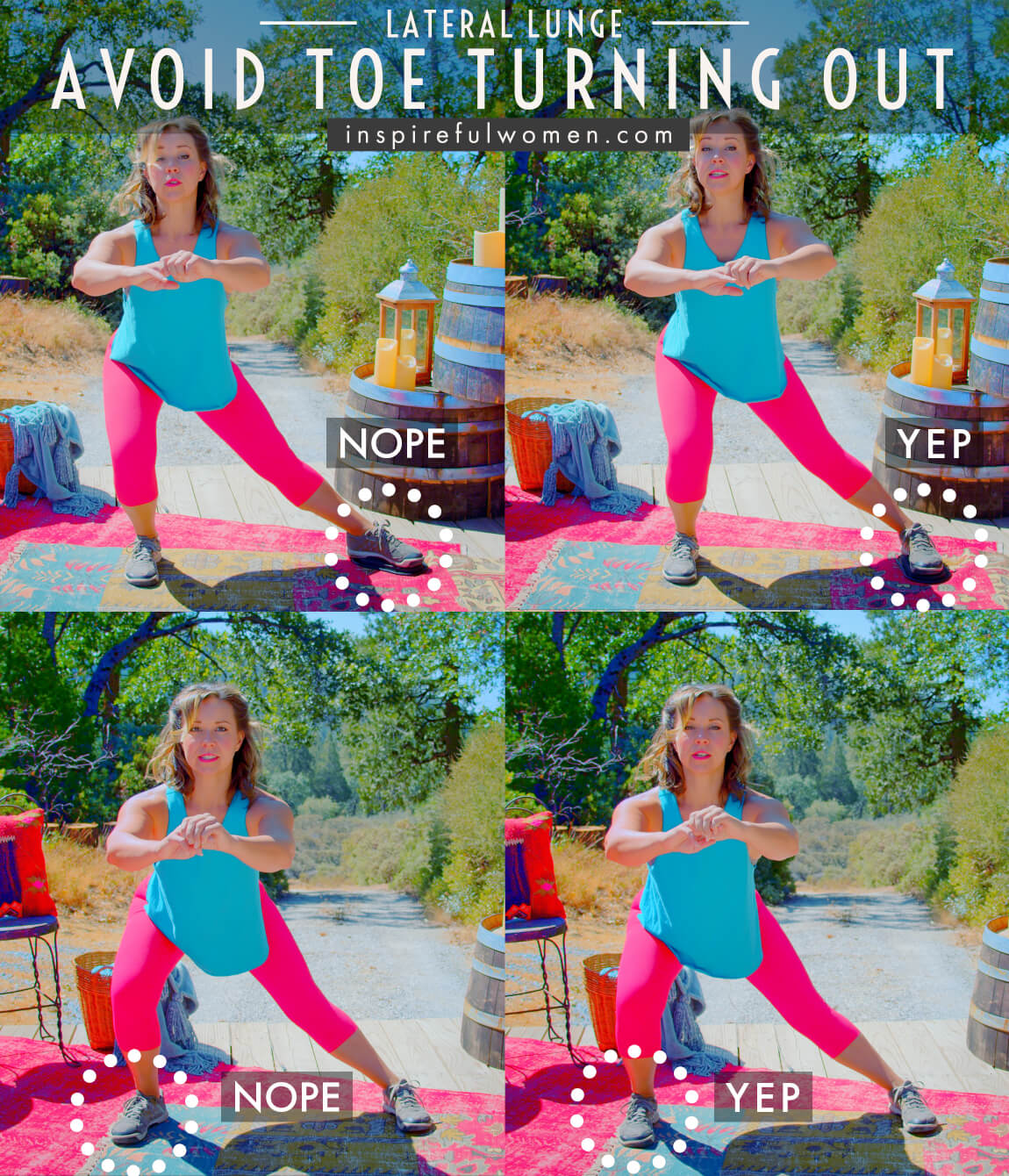
2. Avoid Knee Caving In
AVOID: Avoid letting the lunging knee collapse in or out.
WHY NOT?
- This puts too much strain on the ligaments on the sides of the knee joint.
WHAT TO DO:
- A goal of the exercise is to work the muscles and train the body to move with proper form, this includes the alignment of the leg.
- Keep the thigh in line with the knee, in line with the lower leg and ankle.
- The center of the kneecap should line up with the second and third toes (approximately)
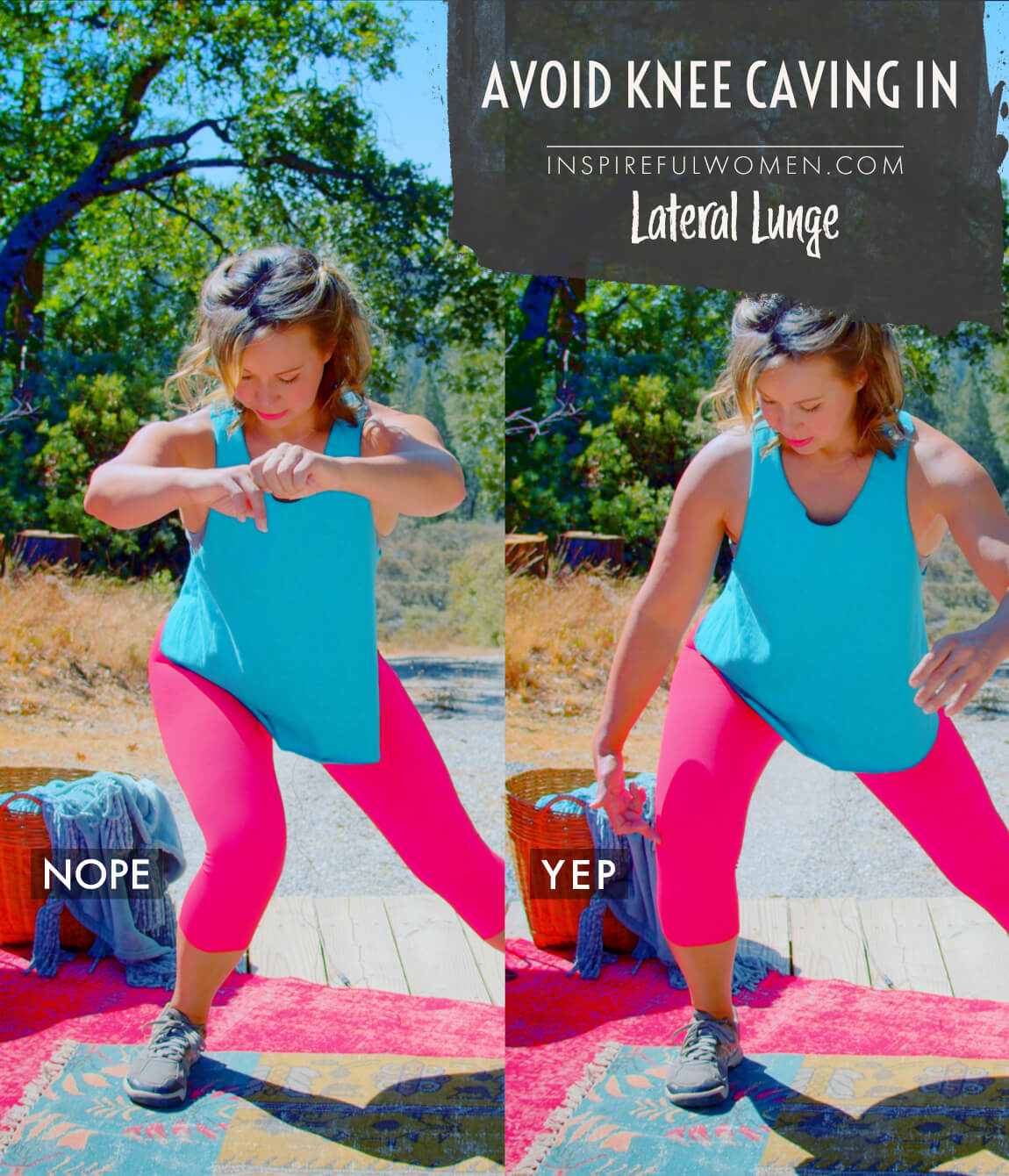
3. Avoid Hip or Pelvis Rotating
AVOID: Avoid letting the pelvis/torso rotate.
WHY NOT?
- Rotating the pelvis or torso will decrease muscle activation in the gluteus medius and minimis.
WHAT TO DO:
- Your pelvis and shoulders should stay facing forward, not turning towards the leg that steps out.
- Try the following:
- Shorten up your stance.
- Put your hands on the top of the pelvis to monitor the movement.
- Use a mirror if possible.
- Limit the depth of your lunge.
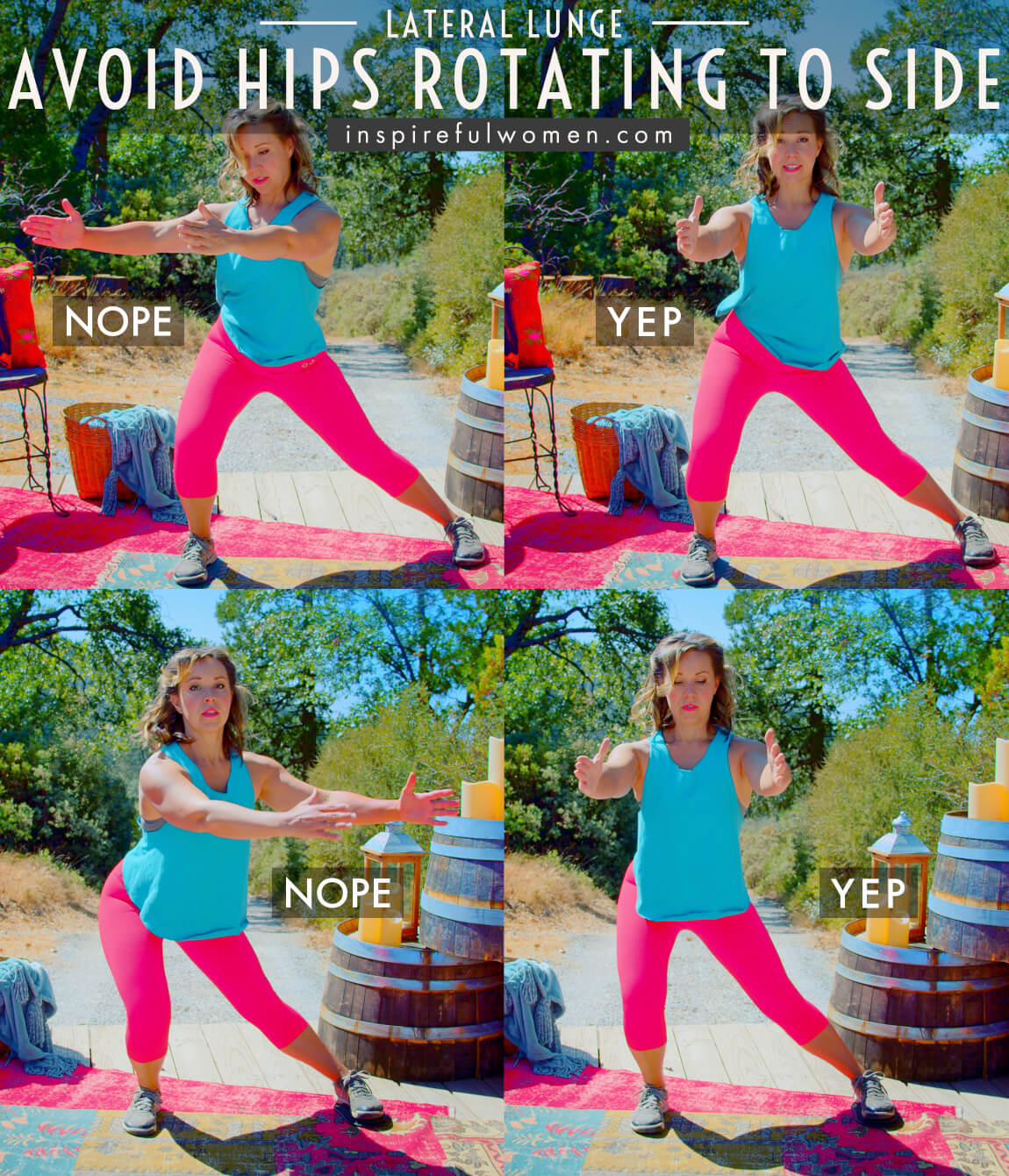
4. Avoid Stepping Out Too Far
AVOID: Avoid stepping out too far.
WHY NOT:
- This can strain the adductor muscles.
WHAT TO DO:
- Start with a smaller (1.5-2 feet) step out to the side, and increase slowly.
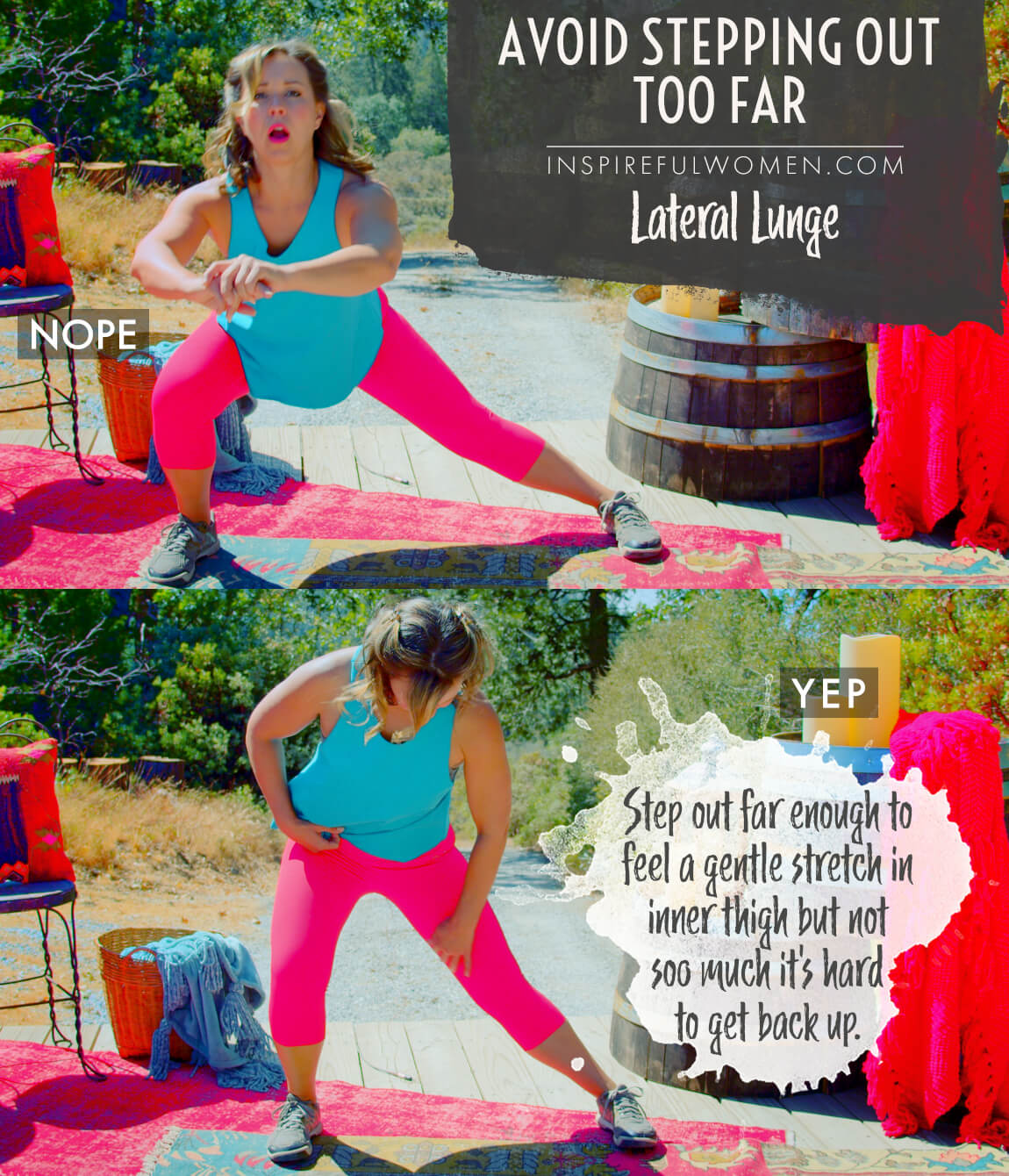
5. Avoid Feet Rolling In or Out
AVOID: Avoid letting the feet roll in or out.
WHAT TO DO:
- A goal of the exercise is to work the muscles and train the body to move with proper form, this includes the alignment of the legs and feet.
- Keep the feet in a position where the weight is evenly distributed on the ball and heel and the arch is lifted.
- The center of the kneecap (of the lunging leg) should line up with the second and third toes (approximately).
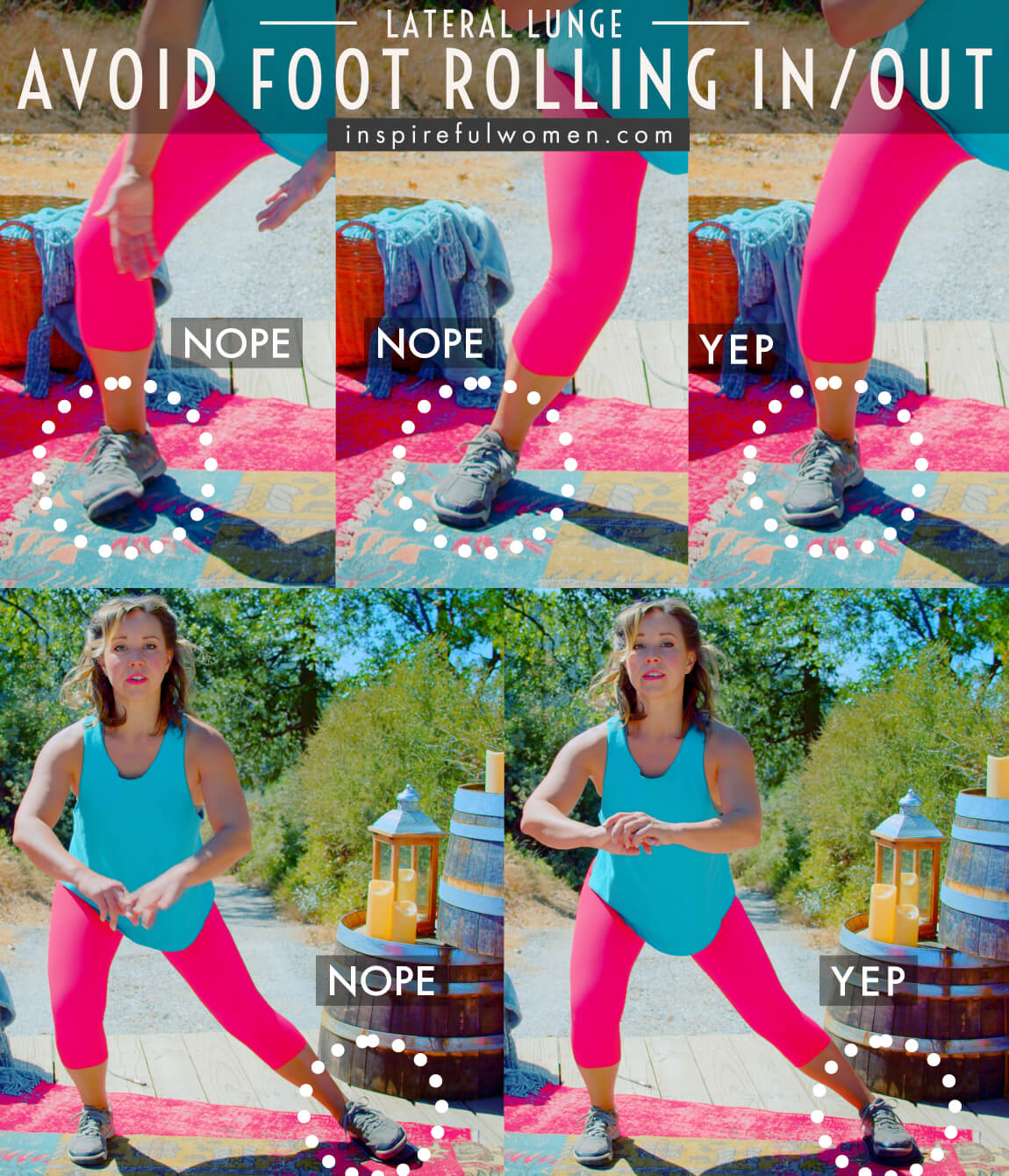
6. Avoid Rounding Spine
AVOID: Avoid rounding your back.
WHY NOT?
- This can strain the ligaments, joints, and muscles of the back.
- Will not work the muscles of the core as much.
WHAT TO DO:
- Keep a neutral spine - keep the weight towards the heels, lift your sternum, and bring your shoulder blades in and down the back.
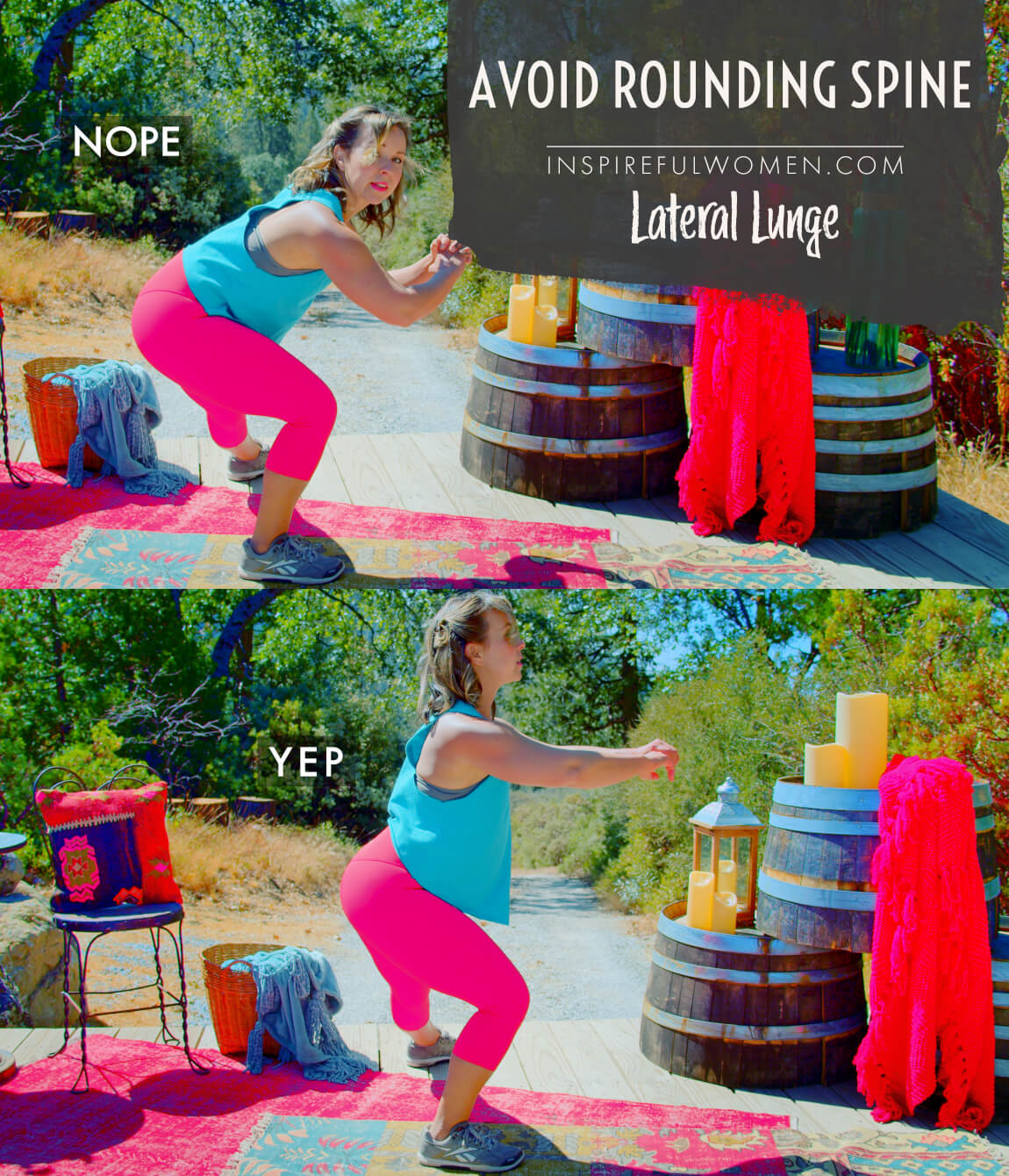
7. Avoid Leaning Torso Too Far Over
AVOID: Avoid leaning too far forward.
WHY NOT?
- This happens when you let the shoulders come too far forward or you roll up onto the toes.
- This can put too much pressure on the front of your knee joint.
WHAT TO DO:
- Keep the weight back in the heel.
- Keep the torso as vertical as possible.
- This requires core strength
- Limit the depth of the lunge until you are strong enough.
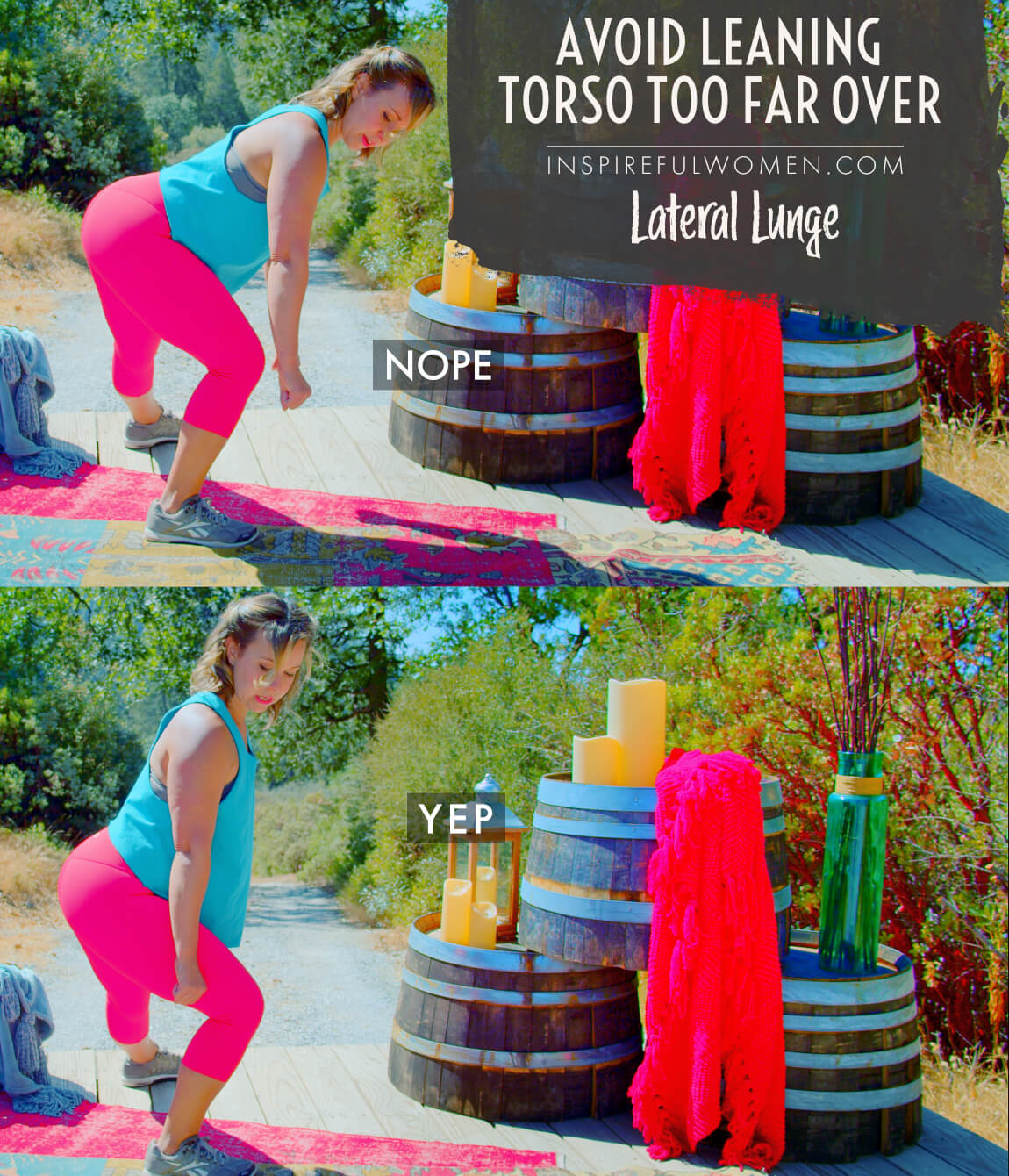
8. Avoid Lifting Heel
AVOID: Avoid lifting the heel of the lunging leg.
WHY NOT?
- This shifts your weight forward and puts too much strain on the front of the knee.
WHAT TO DO:
- Keep the weight evenly distributed on the bottom of your foot - both sides of the heel and both sides of the ball.
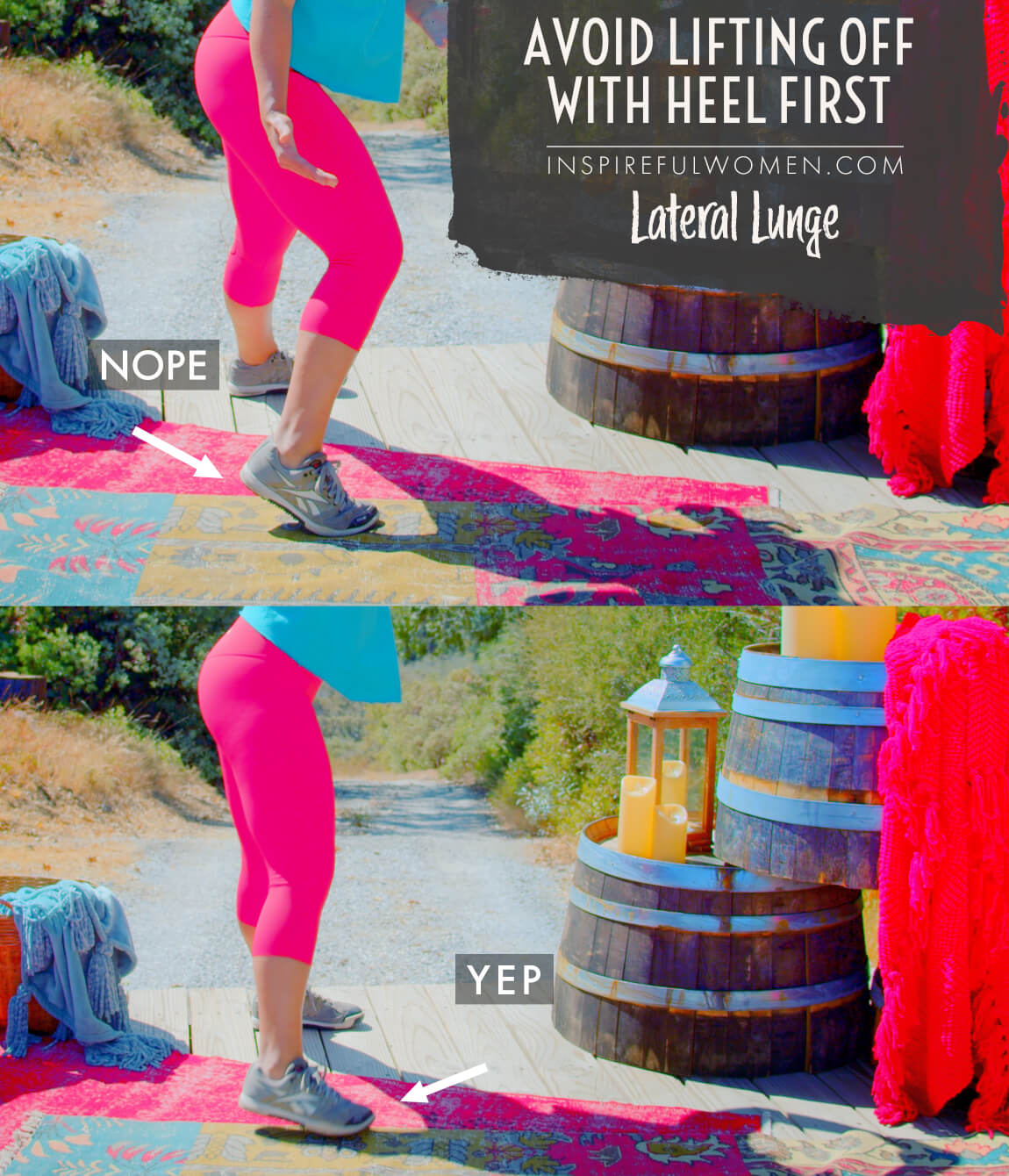
VARIATIONS
VARIATIONS
VARIATIONS OF Bosu Ball Lateral Lunge
On Foam Pad
Foam Pad Lateral Lunge
Use a foam pad instead of a bosu ball
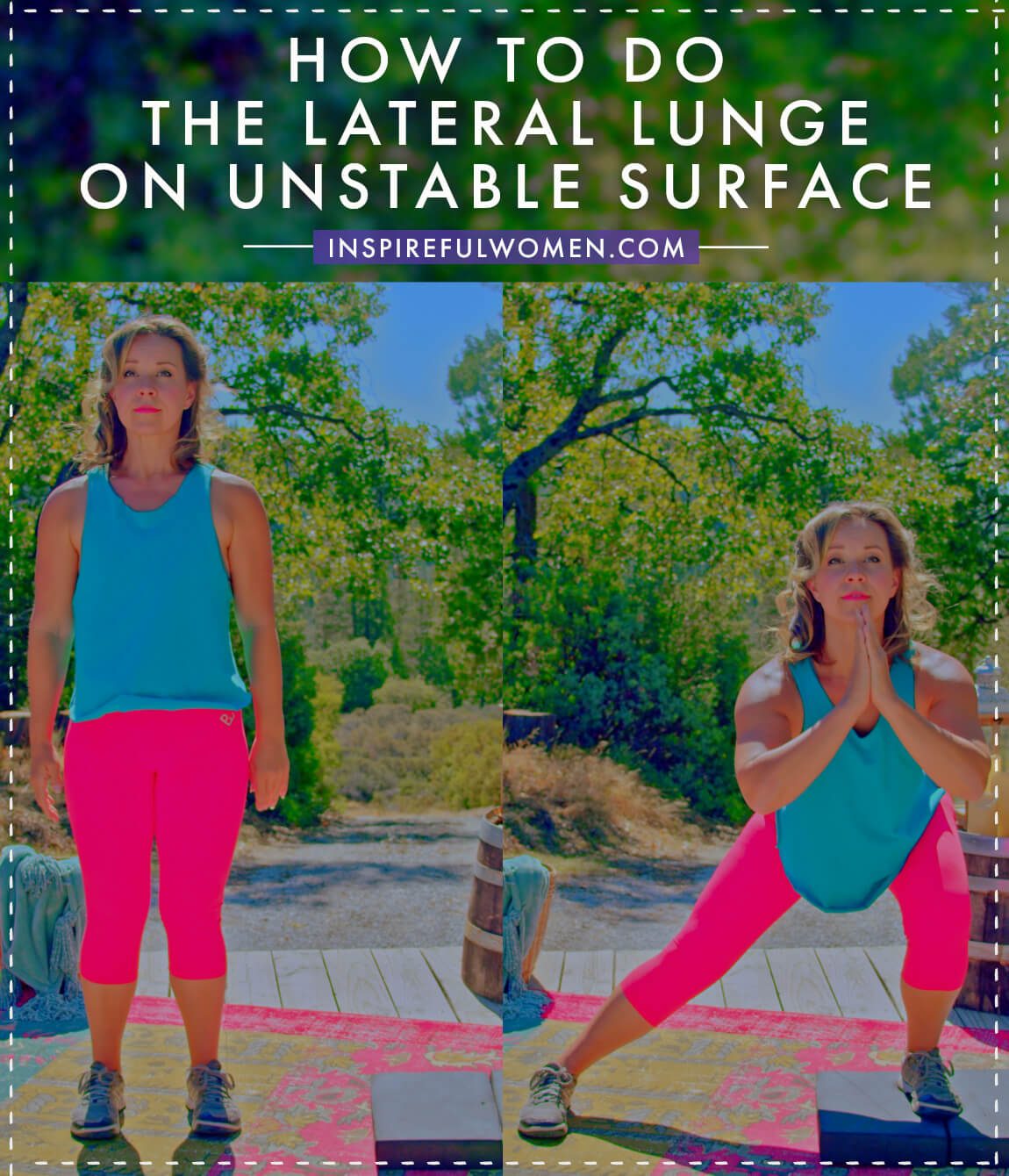
WHAT WE'RE DOING TODAY
WHAT & WHY
BENEFITS OF TRAINING THE Quadriceps, Gluteals, Hamstrings, & Adductors
WHAT
The lateral lunge can start out making you feel clumsy, awkward, and weak. You’re probably thinking what I was thinking when I first started learning them. Who needs this anyway? I think I’ll just head on back over to squats & good lol regular lunges, sheesh.
BUT give your intuitive body a chance to adjust to these movements, as it indeed WILL ladies, because this exercise works your lower half in a unique way.
Side lunges mainly work our quads, glutes, hammies (super scientific speak for hamstrings), and adductors (muscles on the insides of our thighs), and this means it works all of our major lower body JOINTS too- hip, knees & ankles. The unique thing compared to your average lunge or squatNic is that we are moving our body in a side-to-side motion for a change. More on why this is so great in the Why video.
Additionally, you might think this exercise is only for advanced exercising ladies, but that is not the case! We can adjust this move easily with our body weight to make this doable for just about all of us & it will really be worth it.
————-
The lateral lunge is a nice addition to a well-rounded exercise program because it works the legs in a side-to-side motion. Lateral lunges are done by stepping out to the side and then lunging down on one leg by bending at the ankle, knee, and hip. The version of the lateral lunge will determine which leg is doing the lunging. For example, in the standard lunge, the leg that steps out to the side is the one that will do the lunge, but when you use a slider, the leg with the slider moves out to the side while you lunge on the other leg.
This is a compound movement that works the ankle, knee, and hip joints and the muscles that cross them.
Not only can side lunges strengthen the leg muscles, but it also improves muscle flexibility, joint mobility, balance, stability, and coordination. There is an added bonus stretch of the muscles on the inside of the thighs. The exercise is appropriate for those new to exercise as well as the advanced exerciser. Body weight is used for resistance, which makes the exercise convenient for home and travel.
WHY BOTHER DOING IT?
WHY
WHY DO WE EVEN CARE?
Lateral lunges help to improve single-leg strength and stability, as well as ankle mobility. Exercises that involve moving to the side while lunging down - like the lateral lunge requires coordinating the muscle activity as you lunge and step to the side. Lateral lunges move the legs in the side-to-side direction, also called the frontal plane. The lunge movement moves the legs in the front-to-back plane, also called the sagittal plane. A movement that involves more than one joint and moving in more than one plane is considered to be more functional because they are more like everyday activities.
It seems like the majority of leg exercises involve moving the legs forward and backward. It is true that the muscles on the front and back of the legs are much larger than the muscles on the inside and outsides of the legs. And, we do spend more of our day moving in the front-to-back (sagittal) plane of motion. But, it is important to understand that the leg muscles have to work together in coordination to stabilize the pelvis, hip, knee, and ankle joints during all upright activity. In order to be able to do this, the muscles need to be balanced. Strengthening the muscles on the front and back of the legs and not doing anything for the muscles on the inside and outside can create imbalances. The muscles that are worked more, will be too much stronger than the ones that are not. For example, doing quadriceps exercises all the time and never including exercises to strengthen the hip abductors. This could result in the knee collapsing inward when you do forward lunges. The muscles on the side of the hip need to be strong enough to hold the thigh in good alignment in standing and when the knee bends. A well-designed exercise program includes addressing all of the muscle groups. This way the muscles will be more evenly strengthened, and they will be able to work together in coordination, each group capable of doing its job.
With age, the joints of the hips and ankles get stiff and the leg muscles get weaker. The two things, joint stiffness and muscle weakness feed off of each other. When a joint is stiff, the muscles will not get used as much, when the muscles are not used as much, they get weaker and don’t move the joint as much, and the joint will get stiffer. And the reverse can also happen, the muscles get weak, the ankle does not move enough so it gets stiff, and the stiff joint leads to less muscle activity and weakness. This leads to a slowly progressive loss of function. Joint stiffness and leg weakness change the way we move. This can be seen when you watch older people move. They tend to walk slower, flat-footed, and with shorter steps. When they get out of a chair, they tend to lean their weight forward and push up with their hands. Over time, the leg muscles get weaker and the ankle, knee, and hip joints get stiffer. The trend continues, eventually leading to aches and pains in the back, hips, knees, and ankles, and declining function. The good news is that this process can be slowed down with exercises like lateral lunges. The lateral lunge bends the ankle more than forward lunges and uses muscles on the inside and outside of the entire leg, including the ones that cross the ankle which are very important for balance, and stability.
EVERYDAY LIFE
EVERYDAY LIFE &
MUSCLE FUNCTION
HOW WE USE OUR Quadriceps, Gluteals, Hamstrings, & Adductors MUSCLES IN EVERYDAY LIFE
1. THE QUADRICEPS, GLUTEALS, HAMSTRINGS, ADDUCTORS, AND CALF MUSCLES WORK IN COORDINATION TO CONTROL THE LEG (WHEN STILL AND WHEN MOVING) DURING:
- Standing
- Walking
- Running
- Jumping
- Climbing
- Recovering from a slip or trip
- Balancing
- Going up and down stairs
- Transitioning sit to standing to sit
- Squatting down/getting up
- Shock absorbers to protect the ankle, knee, and hip joints during
2. THE HIP ABDUCTORS (GLUTEUS MEDIUS AND MINIMUS)
- The main job of the hip abductors is to hold the pelvis in good alignment when you are standing on one leg
- Walking
- Up and down stairs
- Balancing
- Walking on sloped surfaces like the side of a hill
- Moving your leg out to the side
- Stepping sideways
- Getting into or out of a car
- Help align the leg to prevent the knee from falling inward (knock knees) and the foot from pronating (arch collapsing inward)
3. THE HIP ADDUCTORS (GRACILIS, ADDUCTOR BREVIS, LONGUS, AND MAGNUS) MOVE THE LEG IN TOWARDS THE MIDLINE OF THE BODY
- Especially important for balance and the ability to recover from a slip or trip to prevent a fall
- Lifting your trailing leg into the car
- Crossing your legs
4. THE PLANTAR FLEXORS (GASTROC/SOLEUS):
- Standing on tiptoes
- Walking/running/jumping
- Balance - moves the foot to keep the foot on the ground
- Pushing on the gas pedal
- Going upstairs
- Getting out of a chair
- Getting off the toilet
HOW TO FEEL WHAT MUSCLE IS WORKING
How to Feel What Muscle is Working
Quadriceps: Sitting upright, place your hand on the front of your thigh (of the test leg). Hook the ankle of the other leg to hold the test leg (the leg that your hand is resting on) in place. Try to straighten the test leg by lifting the foot. You will feel your quadriceps contract.
Hamstrings: Scoot to the edge of the seat. Place your hand on the back of the thigh of the test leg. Take the leg off of the front of the ankle and place it behind the ankle. Try to pull the test leg back. You will feel the hamstrings contract.
Gluteals: Place your hands on your bottom - about where they would be if you put your hands in your back pockets - with the palms on your buttocks. Push down into both feet as if you were pressing yourself up to standing. Try to keep the front of your thighs relaxed so that the muscles under your hands contract. Try activating only one side at a time. It is common, especially if you have a history of back or leg injury or pain, to have the glutes on one side that are more challenging to activate. You should work to correct this.
Gastroc/soleus: Sitting in a chair with your foot flat on the floor, placing your hand on your calf. Press down into the floor hard with the toes to lift the heel. You should feel the muscles contract.
Adductors: Lying on your side, put one hand on the inside of the thigh of the bottom leg (held straight) and lift the leg up off of the floor. The adductors will contract to lift the leg.
SCIENCY STUFF
SCIENCY STUFF
SPIFFILICIOUS FACTS ABOUT MUSCLES & MOVES
Gluteals: The gluteal group consists of the gluteus maximus, medius, and minimus. The main function of the gluteus medius and minimus is to hold the hip aligned in the pelvis during standing, walking, and running - all upright activities. The muscles work to abduct the leg. Healthy alignment of the legs is needed in order to load the spine equally - uneven loading of the spine can damage the joints and discs over time - (referred to as degenerative changes or osteoarthritis). [this can also cause an acute - or immediate- injury, with improper lifting or carrying. The gluteus maximus extends the hip (pulls it back from a flexed position and behind the body), and rotates it outward.
Adductors: The adductors include the adductor magnus, longus and brevis, and the gracilis muscles. The adductors are the muscles on the inside of the thigh. The adductors are prime movers for moving the leg in towards the midline, and they help to stabilize the hip.
Quadriceps: The quadriceps is a group of four muscles on the front of the thigh: the vastus lateralis, vastus intermedius, vastus medialis oblique, and the rectus femoris. The four muscles work together to straighten the knee. The rectus femoris crosses both the hip and the knee so it is able to bend the hip and straighten the knee.
Hamstrings: The hamstrings are the three muscles on the back of the thigh - the semimembranosus, semitendinosus, and the biceps femoris. All three muscles can bend the knee and extend the hip (the short head of the biceps does not cross the hip joint - it cannot help to extend the hip).
Gastroc/Soleus: The gastrocnemius and soleus muscles are the two biggest calf muscles. The main function of these two muscles is to point the foot down, also called plantar flexion. The two muscles join together through the achilles tendon which attaches to the back of the heel. These muscles are very active in walking - they are important for pushing off of the ground to propel the body forward. In the lateral lunge, the amount of ankle bend is more than in the forward or reverse lunge, and the amount of calf muscle activity is also greater - to push the body up and back to the starting position.
ALLLL MUSCLES & WHEN
ALL MUSCLES WORKING & WHEN DURING THE Bosu Lateral Lunge
The core (scapular stabilizers, erector spinae, multifidi, obliques, quadratus lumborum, transverse abdominis, rectus abdominis, pelvic floor, and iliopsoas) muscles will be working to maintain an upright posture and neutral spine throughout the exercise.
Stepping out to the side: the muscles of the non-working leg will contract (a combination of eccentric and isometric) to stabilize the leg as the working leg steps out to the side. The abductors of the stepping (working) leg contract concentrically to step out to the side. The weight is shifted over to the working leg. The quadriceps and gluteus maximus work eccentrically to control the weight of the body as the leg bends and you lower down into a lunge. The gluteus medius and minimis contract (combination of isometric, concentric and eccentric) to hold the pelvis level. The muscles around the hip joints of both legs will be working to stabilize the hip, knee and ankle joints.
The working leg hip abductors, gluteus maximus and quadriceps contract concentrically to push the body back up, as the knee and hip get closer to neutral (0 degrees of flexion), the gluteals, hamstring and adductor magnus will become more active to pull the hip to neutral). The hip abductors push the bodyweight back towards the non working leg, to the starting position.
PIN IT FOR LATER!
